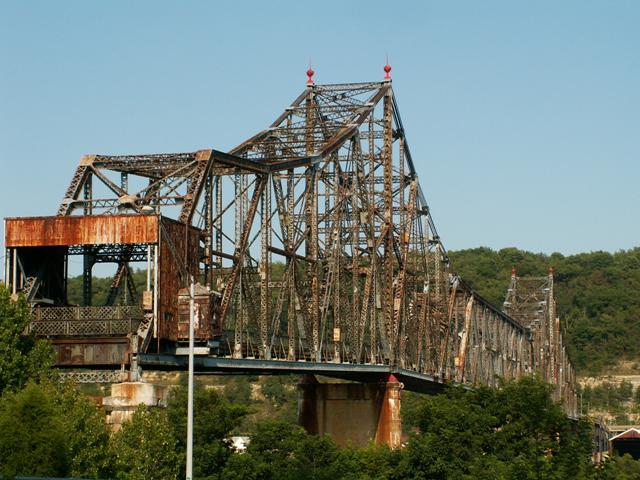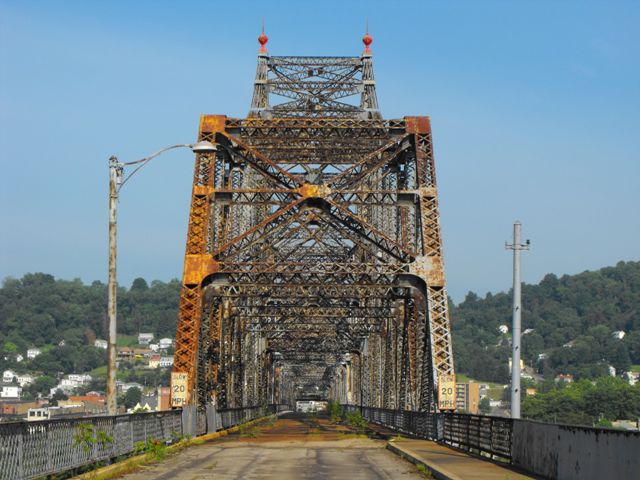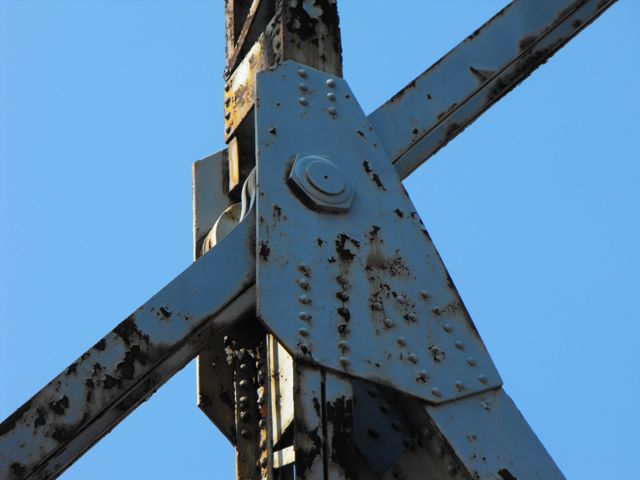We Recommend:
Bach Steel - Experts at historic truss bridge restoration.
Bellaire Bridge
Interstate Bridge

Primary Photographer(s): Nathan Holth, Rick McOmber, and Luke Gordon
Bridge Documented: July 9, 2009 and May 3, 2013
Bellaire and Benwood: Belmont County, Ohio and Marshall County, West Virginia: United States
Metal Cantilever Rivet-Connected Baltimore Through Truss, Fixed and Approach Spans: Metal Deck Girder, Fixed
1926 By Builder/Contractor: Mount Vernon Bridge Company of Mount Vernon, Ohio and Engineer/Design: John Edwin Greiner (J. E. Greiner Company of Baltimore, Maryland and Chicago, Illinois)
Not Available or Not Applicable
700.0 Feet (213.4 Meters)
2,100.0 Feet (640.1 Meters)
Not Available
3 Main Span(s)
Not Applicable

View Information About HSR Ratings
Bridge Documentation
This bridge's future is at risk!
Bridge Status: Alert! As of May 2010, this bridge is now owned by a demolition contractor and its demolition remains planned as of 2013, although court proceedings are buying the bridge some extra time!History and Significance of the Bellaire Bridge
This monumental historic bridge was sometimes called the Bellaire Toll Bridge or simply the Interstate Bridge. The Mount Vernon Bridge Company of Mount Vernon, Ohio and the J.E. Moss Iron Works were both contractors for the superstructure. R. R. Kitchen Company, which was based in Wheeling, did the deck. Vang Construction Company of Cumberland, Maryland was responsible for the substructure. The bridge was designed by J. E. Greiner and Company of Chicago, Illinois. It had an Ohio approach of 670 Feet (204 Meters) which is now removed. The West Virginia Approach Length is 850 Feet (259 Meters). The combined length of the the three cantilever spans is 1250 feet (381 meters)
The bridge was historically and technologically significant as the second oldest highway bridge on the Ohio River that spanned the entire Ohio River, and also for being among the oldest surviving highway cantilever spans in the United States. It was also distinguished as one of the oldest and most unaltered highway cantilever spans in the United States. Despite the removal of the Ohio approach, and some changes made to the West Virginia approach, the main cantilever spans (which were the source of the bridge's significance) were essentially unaltered from their original design. Given that most landmark cantilever bridges are busy bridges that carry heavy traffic across large rivers where there are few crossings, most cantilevers have experienced numerous changes and alterations over their history. The Bellaire Bridge was a rare exception.
The Bellaire Bridge was further distinguished as a surviving pre-1950 cantilever truss bridge in the United States. Pre-1950 cantilever truss bridges are the most at-risk and threated historic bridge type in the country. Due to their large size, only a limited number of them were ever built to begin with (compared to simple span truss bridges under 300 feet for example) yet these bridges are being demolished at an alarming rate. The Ohio, Missouri, and Mississippi Rivers have been the hardest hit by demolition. Most are replaced with mundane modern bridge types such as a cable-stayed or bolted/welded cantilever with rolled beams. These strikingly plain and harsh looking modern structures with no heritage value whatsoever have become a plague upon these scenic landmark rivers.
Ownership and Fate of the Bridge
The bridge operated as a toll bridge under the direction of the Interstate Bridge Company, and it closed to traffic in 1991. ODOT demolished the Ohio approach in 1991. A contractor named Roger Barack bought the bridge, and held ownership of the bridge until 2010. During that time, Barack did not peform any work on the bridge however he was interested in restoring and reopening the bridge to traffic, however he met strong opposition from ODOT, Norfolk Southern Railroad, Bellwood, and the Coast Guard who clearly did not care about the preservation and functional future of the Bellaire Bridge. The Coast Guard and Bellwood wanted the bridge demolished because they think it is a safety problem, largely due to seriously midleading information that was going around. ODOT spent considerable taxpayer dollars to design a new approach ramp for the Bellaire Bridge, but then decided to not build it. Thus, tax dollars were wasted on the design of the approach ramps. Norfolk Southern, who operates a railroad line under the bridge suddenly decided that one of the bridge's piers which has sat on their property since 1926 needed to be removed. They provided no reason for needing it removed, and there are no known plans to expand this railroad line.
Barack ignored orders from the Coast Guard to have the bridge demolished, which eventually resulted in a fine. In 2010 he was forced to sell the bridge to demolition contractors Delta Demolition and Advanced Explosives Demolition. Barack did not make any money as a result of the transfer and indeed lost money during his ownership of the bridge. The bridge was to be demolished in Spring or Summer 2010. However due to a long string of legal problems, this new owner of the bridge has been in court over the bridge and as of December 2013, the bridge remains standing, having defied its fate for three years. HistoricBridges.org hopes that the legal proceedings go on forever and that the bridge never gets demolished. The whole thing is so silly. Benwood thinks the whole bridge is falling apart and wants it demolished, when the only thing falling apart is the small portion of the bridge with a concrete deck. This whole thing could have been solved years ago if someone just removed the section of concrete deck and left the rest of the bridge standing as a monument. The rest of the bridge is in great condition, all rust on the bridge is surface rust and not a danger.
Demolition of Bellaire Bridge: Beyond Stupid
The very thought that such a rare, historic, and beautiful bridge would be demolished should be unthinkable yet has become reality, and this only goes to show how flawed our country's historic preservation laws and transportation policies really are. The Bellaire Bridge was an indispensible resource that should have beeen embraced, not thrown away. The bridge's cantilever trusses were in excellent shape with no major alterations and amazingly little section loss and pack rust, largely because salt was never used on the bridge. Only the concrete portions of the deck was in bad shape on the bridge. Ther bridge's historic and structural integrity made the Bellaire Bridge a top candidate for preservation. Instead this bridge was demolished for no other reason than to eradicate a beautiful historic bridge from the face of the earth and to fill the pockets of demolition contractors and scrap steel companies.
In the end, the bridge was demolished without a single valid reason for doing so. The only part of the bridge for which a sensible reason for demolition was given was the concrete deck. However this is an unacceptable reason for the removal of the entire bridge. At the very least, the deck of the bridge should have been removed and the historic bridge left standing as a non-functional historic landmark. There is this common misperception that a bridge must be functional be left in existance. However, what is a museum but a building full of historic objects that no longer serve a functional purpose other than to preserve something historic or remember a period in history? Historic bridges deserve to be left standing for their historic value alone even if they no longer have a function.
ODOT, Norfolk Southern Railroad, and the U.S. Coast Guard all hold blame for the demolition of the Bellaire Bridge in that order. Former owner Roger Barack was willing to reopen the historic Bellaire Bridge for light vehicular traffic. However ODOT refused to build a new ramp despite having spent tax dollars to engineer such a ramp. ODOT is the main reason why this bridge was demolished. Because of their extremely poor planning and wasting of tax dollars, the bridge ended up without a function. With the Bellaire Bridge demolished, ODOT should be forced to preserve the next most important cantilever bridge in their state, the Ironton Bridge, for pedestrian use next to a vehicular replacement, yet they plan on demolishing this bridge as well.
With the ramp removed by ODOT, the US Coast Guard classified the bridge as not functioning, and ordered it to be removed. As such, they were just doing what the law says, even though such a law is stupid and should be changed so that bridges eligible/listed on the National Register of Historic Places be exempted.
In the meantime, Norfolk Southern, suddenly decided for no apparant reason that after 80 years, they didn't like a bridge pier on their property. Being as the bridge was over 55 years older than Norfolk Southern Corporation, Norfolk Southern should have been required to just live with the pier and deal with it, especially since they had no real reason to have the pier removed.
Lost/Ignored Preservation Opportunities
The Bellaire Bridge is an old and long example of the most complex bridge design ever conceived, the cantilever truss. No other bridge type rivals the cantilever in terms of the complex network of steel, angles, and shape. Their complex geometric art makes these bridges beautiful, and worth preserving on aesthetic value alone. Among these bridges, the Bellaire Bridge stands out as an old, long, and particularly complex example of the type. It also features the important technology of the period, in the form of numerous built-up beams that feature attractive v-lacing and lattice to hold them together. The Bellaire Bridge is a key example of a major cantilever bridge. It represents a design that was used for large bridges in the first half of the twentieth century. Cantilever bridges are few in number across the nation since only so many rivers are large enough to need a cantilever, and moreover large rivers have fewer bridges crossing them. Nevertheless, these bridges, particularly the pre-1950 ones, are facing demolition at a frightening rate. If some are not saved now, it will be too late to save any.
There are several ways to preserve this bridge. The bridge could be restored and re-opened for light vehicular traffic. A ramp would be constructed to reconnect the bridge on the Ohio side. The approach on the West Virginia side could be repaired, or it would also be acceptable to demolish and reconstruct that approach. The main cantilever span is the part with the major historic significance. Another option would be to restore the bridge for pedestrian use only. The least expensive way to go about this would be to demolish the West Virginia approach, restore the cantilever, and construct stairways at each end of the bridge. With this option, the bridge itself could be turned into a park with benches, tables, etc, and also could feature interpretive signage explaining the history of the bridge, river, and the communities of Bellaire and Benwood.
In either solution, a restored Bellaire Bridge would be something that local bed and breakfasts could use to attract visitors to the area. With the proper marketing, the bridge could become a tourism asset for the area. Indeed, the general area shows potential as a historic bridge destination for tourists, with the historic bridges of Wheeling to the North. The restoration of the Bellaire Bridge is a logical choice.
The deck of the bridge is a combination of steel grate and concrete. The concrete sections are in poor shape and need to be replaced. However, aside from this, the bridge is in remarkable structural condition, and is indeed in better shape than many cantilever bridges that are open to traffic, due to the superior care the bridge received when open, as a private toll bridge, which included never using salt during the winter on the bridge. The rust seen on the bridge is only surface rust, and there is little to no section loss or pack rust present on the bridge. This makes the bridge an excellent candidate for preservation.
Final Comments
Preservation of the Bellaire Bridge was not going to be cheap, but it should have been considered essential nevertheless. The benefits of preservation, particularly in years to come as these types of bridges only become more rare through attrition, would have been great. In addition, regardless of cost, the fact remains that the Bellaire Bridge was a rare, beautiful, historic landmark. Also, with its demoltion, any hope of having the communities of Bellaire and Benwood united will die forever. With bridges in Wheeling a few miles to the north, no DOT will spend money on a new bridge here.
Undoubtedly, famous bridges like the Golden Gate Bridge or Brooklyn Bridge are costly to maintain. However, the money is spent because the preservation of the structure is important. Much like the Golden Gate Bridge is a leader in the suspension bridge world, the Bellaire Bridge is a leader in the cantilever bridge world. It deserved the same level of preservation.
![]()
Photo Galleries and Videos: Bellaire Bridge
Structure Overview Beside Bridge
Original / Full Size PhotosA collection of overview photos showing elevation and oblique views for this bridge in the original digital camera resolution. This gallery offers photos in the highest available resolution and file size in a touch-friendly popup viewer.
Alternatively, Browse Without Using Viewer
![]()
Structure Overview On Bridge
Original / Full Size PhotosA collection of overview photos showing views on the bridge deck in the original digital camera resolution. This gallery offers photos in the highest available resolution and file size in a touch-friendly popup viewer.
Alternatively, Browse Without Using Viewer
![]()
Structure Details Connections
Original / Full Size PhotosA collection of photos that show the truss connection detail photos for this bridge in the original digital camera resolution. This gallery offers photos in the highest available resolution and file size in a touch-friendly popup viewer.
Alternatively, Browse Without Using Viewer
![]()
Structure Details General
Original / Full Size PhotosA collection of detail photos that document the parts, construction, and condition of the bridge. This gallery offers photos in the highest available resolution and file size in a touch-friendly popup viewer.
Alternatively, Browse Without Using Viewer
![]()
Structure Overview Beside Bridge
Mobile Optimized PhotosA collection of overview photos showing elevation and oblique views for this bridge in the original digital camera resolution. This gallery features data-friendly, fast-loading photos in a touch-friendly popup viewer.
Alternatively, Browse Without Using Viewer
![]()
Structure Overview On Bridge
Mobile Optimized PhotosA collection of overview photos showing views on the bridge deck in the original digital camera resolution. This gallery features data-friendly, fast-loading photos in a touch-friendly popup viewer.
Alternatively, Browse Without Using Viewer
![]()
Structure Details Connections
Mobile Optimized PhotosA collection of photos that show the truss connection detail photos for this bridge in the original digital camera resolution. This gallery features data-friendly, fast-loading photos in a touch-friendly popup viewer.
Alternatively, Browse Without Using Viewer
![]()
Structure Details General
Mobile Optimized PhotosA collection of detail photos that document the parts, construction, and condition of the bridge. This gallery features data-friendly, fast-loading photos in a touch-friendly popup viewer.
Alternatively, Browse Without Using Viewer
![]()
2009 News Story
Full Motion VideoWTRF7 interviews the HistoricBridges.org team regarding the Bellaire Bridge in July 2009. Streaming video of the bridge. Also includes a higher quality downloadable video for greater clarity or offline viewing.
![]()
2010 News Story
Full Motion VideoWTOV9 interviews the HistoricBridges.org team regarding the Bellaire Bridge in June 2010. Streaming video of the bridge. Also includes a higher quality downloadable video for greater clarity or offline viewing.
![]()
Maps and Links: Bellaire Bridge
Coordinates (Latitude, Longitude):
Search For Additional Bridge Listings:
Bridgehunter.com: View listed bridges within 0.5 miles (0.8 kilometers) of this bridge.
Bridgehunter.com: View listed bridges within 10 miles (16 kilometers) of this bridge.
Additional Maps:
Google Streetview (If Available)
GeoHack (Additional Links and Coordinates)
Apple Maps (Via DuckDuckGo Search)
Apple Maps (Apple devices only)
Android: Open Location In Your Map or GPS App
Flickr Gallery (Find Nearby Photos)
Wikimedia Commons (Find Nearby Photos)
Directions Via Sygic For Android
Directions Via Sygic For iOS and Android Dolphin Browser
USGS National Map (United States Only)
Historical USGS Topo Maps (United States Only)
Historic Aerials (United States Only)
CalTopo Maps (United States Only)









